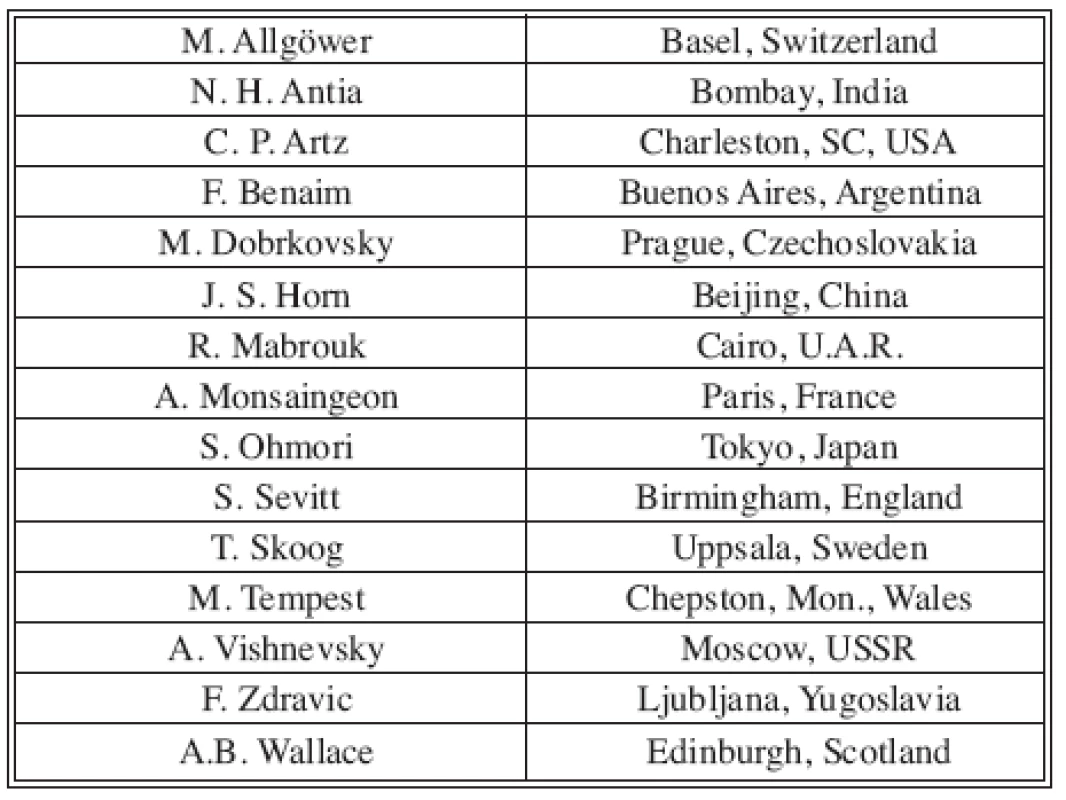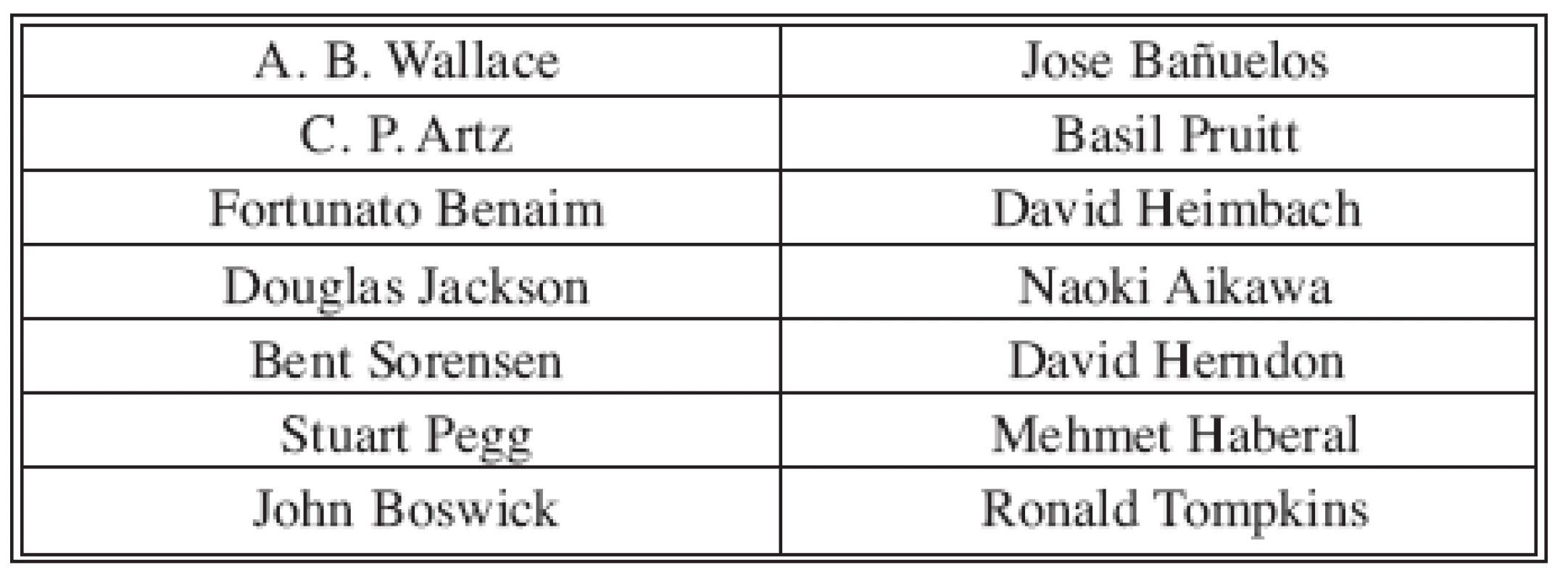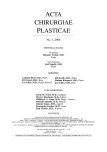CONGRESS HISTORY OF THE INTERNATIONAL SOCIETY OF BURN INJURIES
Autoři:
M. Haberal
Působiště autorů:
Department of General Surgery and Transplantation and Burn Institutes, Faculty of Medicine, Baskent University, Ankara, Turkey
Vyšlo v časopise:
ACTA CHIRURGIAE PLASTICAE, 50, 4, 2008, pp. 101-104
The founders of the International Society for Burn Injuries first convened at the National Naval Medical Center in Bethesda, Maryland in September 1960, for the First International Congress on Research in Burns, which was sponsored by the U.S. Army, U.S. Navy, U.S. Air Force and the U.S. Public Health Service. The meeting, with international participation, was coordinated by Curtis P. Artz, and was considered such a success that a Second Congress was scheduled.
This 2nd Congress, organized by A. B. Wallace, was held in Edinburgh in September 1965. The organizers and participants were so pleased with the results that it was decided that an International Congress should be held every five years. In fact, it was during this meeting that a proposal to create the International Society for Burn Injuries (ISBI) was presented and approved by the General Council, along with a Constitution and Bylaws, which laid out the aims of the Society, along with stipulations regarding membership (divided into Full, Associate and Honorary Life memberships) and the authorities of the society (Executive Council, General Council, General Assembly, and Action Committees).
The goals of the society were certainly worthy in intention and, as can be seen through the course of the history of the Society, without a doubt carried out to the full.
Aims of ISBI:
- To disseminate knowledge
- To stimulate prevention
- To promote and coordinate research
- To promote education
- To encourage high standards of care
- To encourage coordination
The Original Executive Committee of the ISBI was decided (Table 1, 2). The Executive Committee represented 13 countries, embracing the international nature of the society, and A. B. Wallace was pronounced Secretary General, a post which he held until his death in December 1974.


The 3rd Congress of the now newly formed ISBI took place in 1970 in Prague, Czechoslovakia. The Congress was organized by R. Vrabec and Z. Koníčková, and many of the proceedings took place at the renowned Charles University. In the light of the rapid developments experienced in the field of burns, it was suggested that the Congresses be held every four years rather than every five. Thus, it was decided by the General Assembly that the next ISBI Congress would be held in Buenos Aires, Argentina.
The 4th International Congress was organized by Dr. Fortunato Benaim in Buenos Aires, followed by the 5thCongress, which was organized by Bent Sörensen, Gösta Arturson and Bengt Nylen in Stockholm, Sweden in 1978.
A. B Wallace passed away in December 1974, and the position of Secretary General was taken on by Dr. John Boswick. The 6th Congress, held in San Francisco, USA in 1982, was hosted by Dr. Boswick as both Secretary General of the Society and Chairman of the Organizing Committee, with the assistance of Basil Pruitt and William Curreri.
The 7th International Congress was once again presided over by Dr. Boswick as Secretary General, in Melbourne, Australia in 1986, and the Congress was skillfully organized and hosted by A. M. Clarke, J. Solomon and J. Masterton.
The 8th International Congress on Burn Injuries took place in New Delhi, India, in November 1990, and was hosted by Manohar Keswani. During this Congress the position of Secretary General, the member responsible for the Society’s administrative business, was replaced by a President, and the Associate Secretaries by three Vice Presidents. The General Council was integrated by a representative of each geographic area. Dr. John Boswick’s term as Secretary General, which began in 1975, came to an end during this Congress, and he was replaced by José BaĖuelos, from Barcelona, Spain, as President of the ISBI.
The 9th Congress of the ISBI in Paris, France, held in late June and early July of 1994, was hosted by Dr. Serge Baux, with the assistance of Drs. Laterjet and Wasserman. Dr. Basil Pruitt was elected to be the next President, and his term began immediately afterwards. In 1998 the 10th Congress of the ISBI was held in Jerusalem, Israel under the Presidency of Dr. Pruitt and was organized by Dr. Eldad, with the assistance of Dr. Rosenberg. Dr. David Heimbach was elected President of the ISBI for the term 1998–2002, and the 11th Congress was held in Seattle, USA, over which Dr. Heimbach presided as both President of the Society and Chairman of the Organizing Committee. During this Congress the General Assembly approved a motion to decrease the Presidential term from 4 to 2 years and to hold the ISBI International Congress every two years rather than every four years as had been done previously. Consequently the 12th Congress was held in 2004, in Yokohama, Japan. Dr. Naoki Aikawa was President of the Society, and Motohiro Nozaki hosted the Congress as Chairman of the Organizing Committee. In Yokohama I had the honor of being elected President-Elect. David Herndon was elected President of ISBI, and he presided over the 13th Congress, which was held in Fortaleza, Brazil in 2006, hosted by Dr. Nelson Piccolo. It was during the Congress in Fortaleza that I began my term as President of the ISBI for the years 2006–2008.
My interest in burn care began when I was still a resident at Hacettepe University Medical School in Ankara, Turkey. After I was appointed Assistant Professor in 1971, I began to apply to several universities in the United States in the hope of going there and learning more about transplantation and burn care, two exciting and growing fields. After several months of eager anticipation I was accepted as a Fellow at the Shriners Burns Institute and at John Sealy Hospital in Galveston, Texas. So on February 3rd1973 I went to the United States, where I studied with Drs. Duane Larson and Mario Dobrkovsky and learned a great deal about clinical burn care, rehabilitation and experimental studies.
It was during this period in my life that I had the honor of meeting many pioneers in the field of burns, including Drs. Truman Blocker, Stephen Lewis, and two of the founders of the ISBI, A. B. Wallace and Fortunato Benaim. Dr. Benaim was presented with a certificate by Dr. Blocker and a golden key by Dr. Larson on April 4th, 1973. Later that same year, during the Annual Meeting of the American Burn Association in Dallas, I was also introduced by Dr. Dobrkovsky to Drs. Curtis P. Artz, Bruce Macmillan, Giovanni Dogo and other who have played important roles in the shaping of the field.
I had the pleasure of meeting Dr. John Boswick, who later became Secretary General of the ISBI, at the American Burn Association Annual Meeting, held in Denver in 1975. The time I spent in America in the company and under the influence of such fine physicians served to strengthen my dedication to the care of burn patients and I became a member and a national representative of ISBI myself in 1975. From 1982–1986, I held the position of Eastern Mediterranean Representative, after which time I was Associate Secretary General until 1990. From 2002–2004 I acted as Chairman of the Disaster Planning Committee and published a booklet entitled “Guidelines for Dealing with Disasters Involving Large Numbers of Extensive Burns” (Figure 1). In 2004, during the 12th Congress of the ISBI held in Yokohama, Japan, I was elected President-Elect of the ISBI. I began my term in 2006, at the 13th International Congress of the ISBI, which took place in Fortaleza, Brazil. My term as president ended in September 2008, at the close of the 14th International Congress of the ISBI, which was held in Montreal, Canada and was organized with great care and dedication by Drs. Redouane Bouali and Edward Tredget. During the closing ceremony, with the passing of the President’s symbol, a gold medallion engraved with the ISBI logo, I passed on the Presidency to Dr. Ronald Tompkins (Figure 2).


The next Congress, to be held in Istanbul in 2010, marks the 50th Anniversary of the International Society for Burn Injuries. It is an honor for me to be able to host this Congress on such a special occasion. The ISBI has come a long way since its first inception, but without ever abandoning its ideals.
Over the years the number of scientific papers presented, and the number of participants from all around the world, have continued to increase. It is indeed a privilege to be part of such an extraordinary society as the ISBI, with its wealth of knowledge, activity and culture.
In the last decade in particular, the ISBI has proven its commitment to achieving its goals by disseminating knowledge and stimulating prevention in the field of burns. The society has endorsed and sponsored regional and national meetings; awarded grants to professors participating in congresses in other countries and members who wanted to visit other burn centers; organized educational courses in different countries; and collaborated with the WHO as a nongovernmental organization.
“Burns happen anywhere, anytime, to any one. . . ”
Cognizant of this fact, training burn-care specialists in other countries is imperative. Funds for education and training and organizing regional training programs and educational courses should be made available. Participating in international congresses is critical for healthcare staff to interact with their colleagues. Unfortunately, economic factors in certain countries make this difficult.
Increasing the number of members in countries where membership rates are particularly low or entirely absent would allow healthcare professionals to benefit from the Society’s activities. Encouraging and promoting burn societies in countries where there are none is vital.
In reaching this target, a well-functioning chain of information, beginning with the national representative, to the regional representative, to the committee chairmen, to the secretary, and finally to the president, is of utmost importance, thus maintaining contact and coordination at every stage.
In 2005 I had the honor of being presented with the International College of Surgeons Honorary Fellowship Award. The Prague Burn Center is also an institution with a full and vibrant history, just like the city itself. Established in 1953 By Prof. Francis Burian, the Prague Burn Center was created in response to wartime experiences. His dedication to the field led to his creation of a specialized burn unit, providing total care to burn patients as a separate field from plastic surgery. Forty-four years later the physicians and staff of this extraordinary institution continue to carry out their work with great care and dedication.
Prague has indeed become an important city in my life. It was a privilege to be invited by my colleagues and friends, Professor Miloš Hájek and Honorary President of the Conference, Professor Radana Königová, both of whom I hold in the highest esteem (Figure 3), to attend the Jubilee Conference on the Occasion of the 55th Anniversary of the Prague Burn Center, and it is a great honor of the highest order to receive an Honorable Membership from the Czech Medical Association (Figure 4). I shall carry this memory and this valuable gift with me always, and I shall forever remain a friend and a supporter of the fine people who continue to carry out their important work here.


Address for correspondence:
Mehmet Haberal, M.D., FACS, FICS (Hon)
Founder and President,
Baskent University
1. Cadde, No: 77
Bahcelievler 06490
Ankara
Turkey
E-mail: rektorluk@baskent-ank.edu.tr
Zdroje
1. Pruitt Jr. B.A. ISBI Presidential Address: The development of the International Society for Burn Injuries and progress in burn care: the whole is greater than the sum of its parts. Burns, 25, 1999, p. 683–696.
2. Benaim F. Brief history of I.S.B.I. and its congresses. Burns, (33)1, 2005, p. S162–S168.
3. Haberal M. My Life in Burns. Ankara: Baskent University Publishers. 2008.
Štítky
Chirurgia plastická Ortopédia Popáleninová medicína TraumatológiaČlánok vyšiel v časopise
Acta chirurgiae plasticae

2008 Číslo 4
- Metamizol jako analgetikum první volby: kdy, pro koho, jak a proč?
- Fixní kombinace paracetamol/kodein nabízí synergické analgetické účinky
- Antidepresivní efekt kombinovaného analgetika tramadolu s paracetamolem
- Kombinace metamizol/paracetamol v léčbě pooperační bolesti u zákroků v rámci jednodenní chirurgie
- Srovnání analgetické účinnosti metamizolu s ibuprofenem po extrakci třetí stoličky
Najčítanejšie v tomto čísle
- ENZYMATIC NECROLYSIS OF ACUTE DEEP BURNS – REPORT OF PRELIMINARY RESULTS WITH 22 PATIENTS
- CONGRESS HISTORY OF THE INTERNATIONAL SOCIETY OF BURN INJURIES
- HEMOCOAGULATION DISORDERS IN EXTENSIVELY BURNED PATIENTS: PILOT STUDY FOR SCORING OF THE DIC
- ETHICAL PROBLEMS IN BURN MEDICINE
